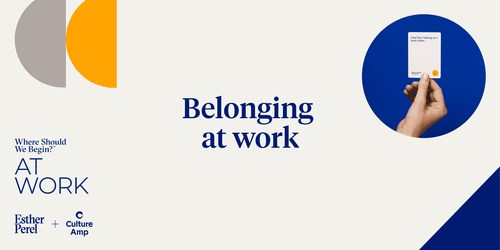
Article
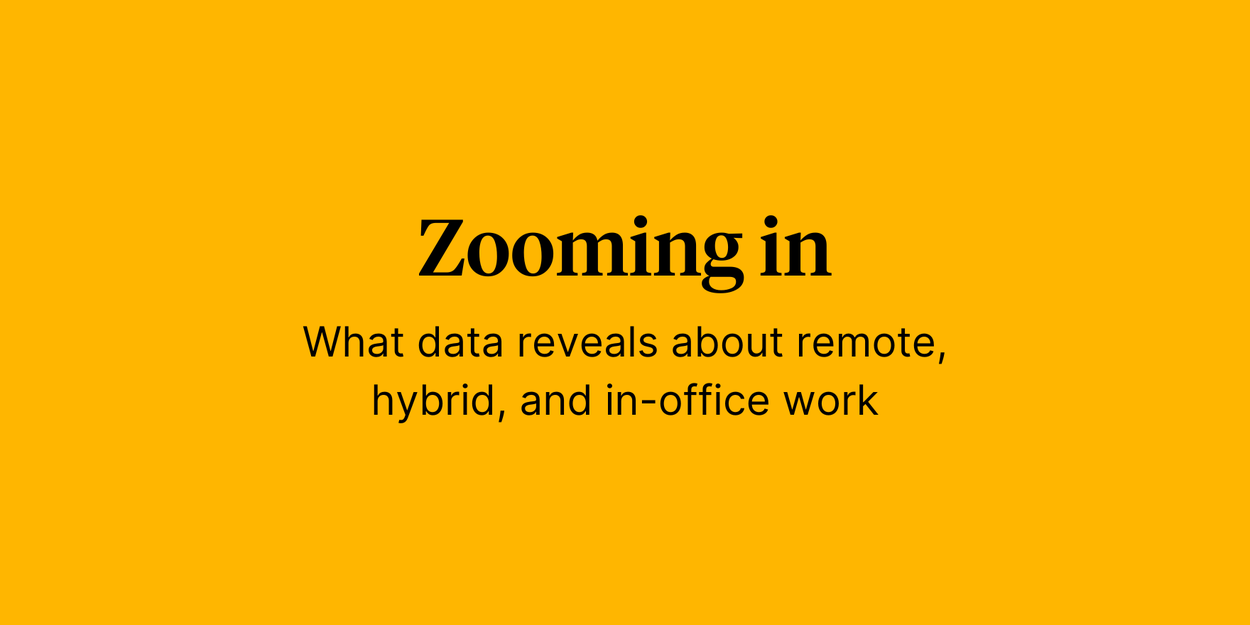
Written by

Director of People Science Research, Culture Amp

Lead People Scientist, Culture Amp
Remote and hybrid work is here to stay. The Survey of Working Arrangements and Attitudes found that in July 2024, 29% of paid days in the US were work-from-home days, a number that has been stable over the last year. But if you listen to the chatter in the boardroom (or Slack channels and Zoom calls), you might think it’s a passing fad.
There’s no shortage of myths swirling around remote and hybrid work, from the notion that remote employees are lounging in pajamas all day to fears that remote employees won’t have a fair shake when it comes to performance review season. And some of these misconceptions are based on sound psychological theories. But before you throw out the couch cushions and go back to cubicles, let’s use data to separate fact from fiction.
In this article, we’ll explore common beliefs about remote and hybrid work, determine if they’re fact or fiction, and share Culture Amp data that backs up that designation.
Recently, Nature published a randomized control trial (the gold standard for research). The researchers found that after one year, teams randomly assigned to hybrid working were more satisfied and had no difference in performance. Additionally, their quit rates were reduced by a third.
⚖️ Verdict: Fiction
However, that research only looked at one company. At Culture Amp, we work with thousands of companies, and some of them consider where an employee works as they interpret their employee survey results. Looking at our data, we were able to identify and categorize employees as:
We analyzed the results of 241,605 employees from 735 companies who responded to a Culture Amp survey from July 2023 to July 2024. Regionally, 55% of the companies are based in North America, 16% in EMEA, and 12% in APAC. In terms of industry, 35% of the companies are tech, followed by professional services (20%), science and research (8%), healthcare (5%), and others. This article focuses on our data because that’s what we know best. For a thorough review of external literature, check out Talent Strategy Group’s article.
While intuitively, that makes sense, our data shows that remote employees feel more positively about collaboration, consultation, and communication than their in-office or hybrid peers. Perhaps remote colleagues have found more efficient ways to collaborate using the digital tools we have access to (and learned to use competently during COVID-19) without the inefficiencies that plague in-person chats. Simply bringing leaders and managers who don’t have meeting acumen or are not inclined to collaborate into the office won’t solve those woes.
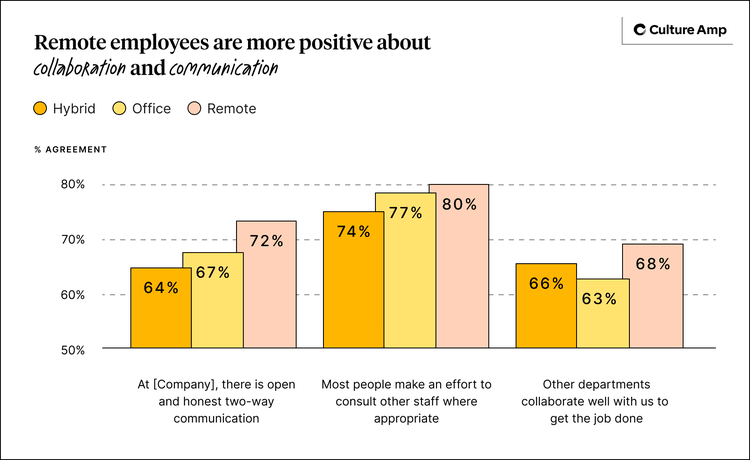
⚖️Verdict: Fiction
Few companies were as innovative in the 20th century as Bell Labs, which invented things as varied as lasers and solar cells. The Idea Factory credited this innovation to a few things, but most importantly, identifying top talent and making them physically bump into each other down long hallways, calling these intellectual/creative collisions. In the return-to-office world, companies have latched onto this idea.
However, while 72% of remote workers agreed with the statement “At [Company], we act on promising new or innovative ideas,” only 68% of office workers and 67% of hybrid workers did. So, according to the data, office workers have a slight edge on hybrid, but remote workers have an edge on office. This suggests that, as with collaboration, remote employees have identified tools and work processes that spur innovation (e.g., Miro), and these might not translate when some people are in the office and others, remote.
⚖️Verdict: Fiction
Even folks who think remote work is the future concede that onboarding and enablement of new hires is easier to do in person. So what does the data say? When it comes to clarity in role expectations, there is no difference between remote and office employees. However, it is easier for office workers to access the information they need. They are also more likely to feel that the systems and processes in place are effective, likely because many of those processes were originally created for in-office work and may not have evolved for the digital space.
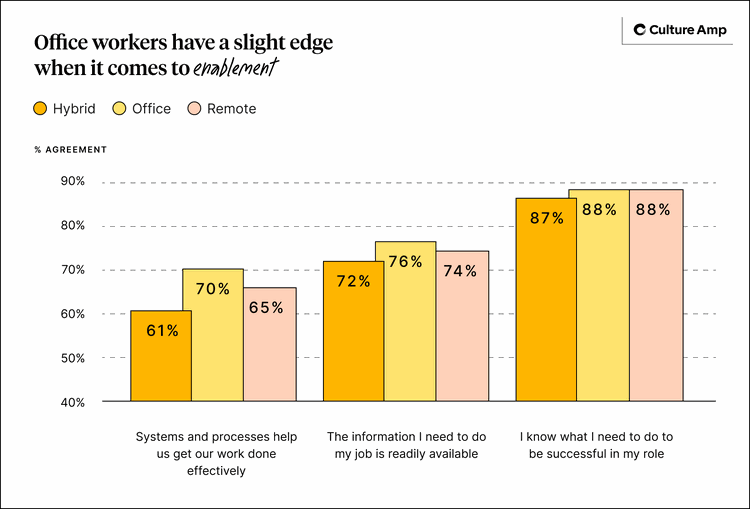
⚖️Verdict: Fact
It’s understandable to believe that employees would more easily connect with their manager and the leadership team when everyone is together in the same physical space. However, in our data, we see that on every single question relating to managers or leaders (nine total), remote employees score highest. Office workers score lowest, with the gap ranging from 4% to 9%. This suggests managers and leaders are finding ways to create strong relationships with their remote employees.
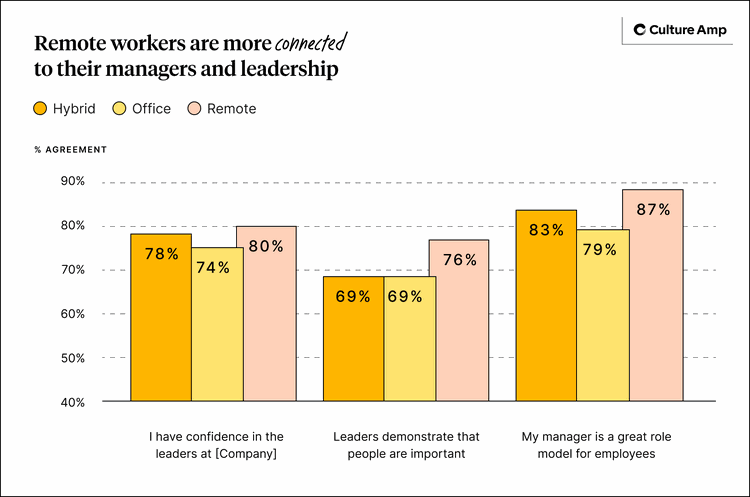
⚖️Verdict: Fiction
While many of the myths listed above stem from the idea that office work is better for organizations and business outcomes, this one reflects a concern that remote workers may be at a disadvantage. The basis is proximity bias, essentially managers favoring employees physically near them in the office. However, the Nature study found no difference in performance ratings or promotion rates for the following two years.
Outside of outcomes, how do employees feel? Again, we find remote employees are most positive about the right people being rewarded and recognized, their performance being evaluated fairly, and receiving appropriate recognition.
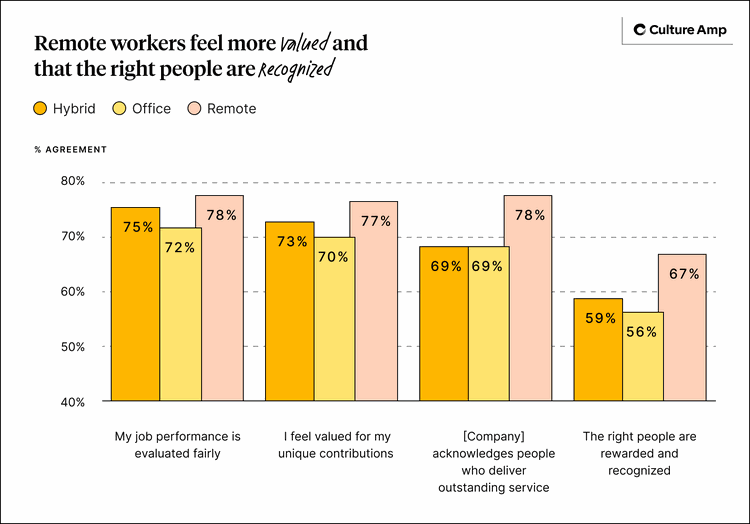
⚖️Verdict: Fiction
When it comes to engagement, how emotionally connected and committed employees are to the organization, we’ve heard all sorts of beliefs:
- “The cohesion created in the office leads to higher employee engagement.”
- “Remote employees respond to the autonomy and trust shown by their company with higher engagement.”
- “Having the option to work both from home and the office helps people balance their lives better, making them happier and more engaged."
What does the data say about which workers are the most engaged?
In our data, we find remote employees are most engaged. The largest difference is in their present commitment (whether they’re looking for another job), followed by their motivation and likelihood to recommend the company. So at least for those still working remotely in 2024, they are happy to have that opportunity.
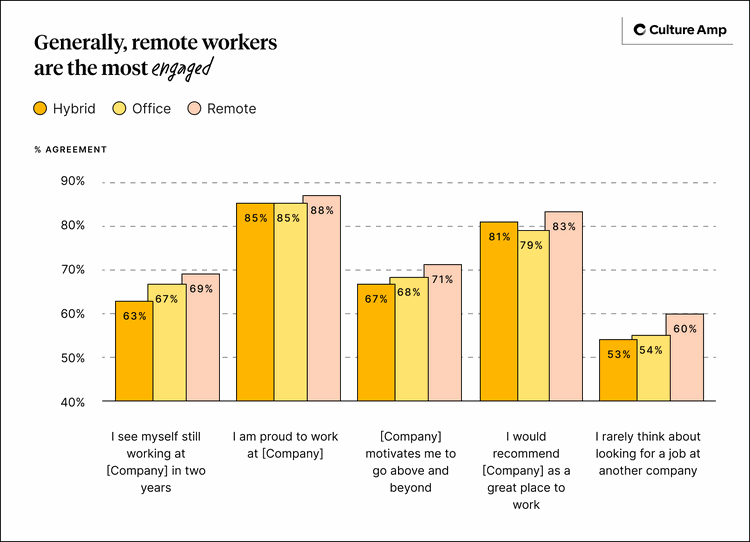
Interestingly, the lower-scoring group switches back and forth between hybrid or in-office. Importantly, this research only considers the individual’s working location. It does not take into account the working styles of the entire organization. Presumably, there is a big difference between being the only remote worker on your team and being part of the 10% of the company that goes into an office. While not covered in this research, we recognize this as another area worth studying.
In general, we found that most of the common beliefs companies have about remote and hybrid working are fiction. However, the best working style can vary greatly based on the role itself, the industry, the organization’s culture, and individual preferences and circumstances. So, how can you apply these learnings at your organization?
According to our data, many widespread beliefs against remote working are fictitious. In fact, remote working has many benefits, including:
To mitigate the challenges of remote working, you can:
While our data showed the employee experience of office workers is generally lower, in-office work has some benefits, including:
To mitigate the challenges of office working, you can:
Hybrid work models may be a strategic differentiator for organizations looking to focus on:
But as our data shows, given that hybrid employees are sometimes the lowest scoring group, the execution of hybrid working arrangements is crucial to get right. Otherwise, the benefits associated with the model can be flipped and end up as amplified challenges. Consider:
As we wrap up our analysis of the facts and fiction around remote, hybrid, and in-office work, it’s clear that old assumptions about productivity and collaboration are due for a rethink.
Within Culture Amp’s data spanning over 700 companies, remote employees demonstrate the ability to excel in innovation, collaboration, and recognition, while maintaining productivity. However, it’s true that office workers do have a slight edge when it comes to enablement. That said, averages are, well, averages. Different working styles suit different people and organizations, and the key is finding what works best for you.
Whether you’re navigating the office or working from home, leveraging the tips in this article can help your organization optimize your environment and approach, ensuring that your teams thrive no matter where they are.
